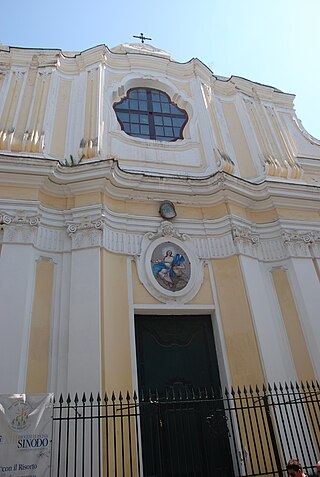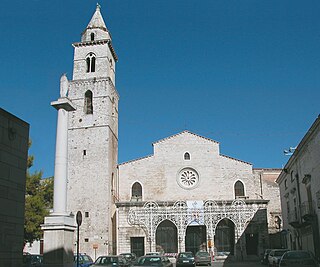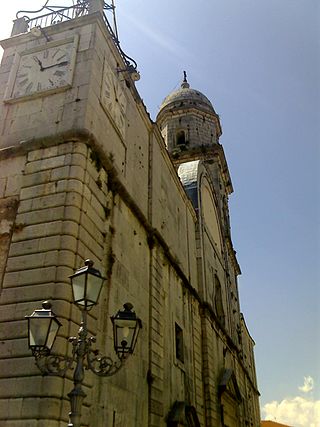
The Archdiocese of Taranto is a Latin archdiocese of the Catholic Church in southern Italy, on a bay in the Gulf of Taranto.

The Archdiocese of Amalfi-Cava de' Tirreni is an archdiocese of the Latin Church of the Catholic Church, with its episcopal see at Amalfi, not far from Naples. It was named Archdiocese of Amalfi until parts of the Diocese of Cava e Sarno were merged with it on September 30, 1986.

The Diocese of Saluzzo is a Latin diocese of the Catholic Church in the Piedmont region of northwestern Italy, centered in the comune of Saluzzo. The diocese was established on 29 October 1511 for political reasons, to transform the Marquisate of Saluzzo into an ecclesiastic territory, and was directly dependent upon the Holy See. It is now a suffragan of the Archdiocese of Turin.

The Archdiocese of Reggio Calabria-Bova is a Latin Church ecclesiastical territory or diocese of the Catholic Church in Calabria, southern Italy. It received its current title in 1986, when the independent Diocese of Bova was suppressed, and the territory and title of the diocese added to that of the Archdiocese of Reggio.

The Diocese of Bovino is a Latin Church diocese of the Catholic Church in the civil province of Apulia, southern Italy. It is 23 mi (37 km) southwest of Foggia. It was established in the tenth century, and was a suffragan of the archdiocese of Benevento. In 1986 it was merged into the Archdiocese of Foggia-Bovino. In 1980, the diocese claimed 23,500 adherents, served by 26 priests.

The Diocese of Teramo-Atri is a Latin diocese of the Catholic Church in Abruzzo, central Italy. The current extent of the diocese was established in 1949, when the historic Diocese of Teramo was combined with the Diocese of Penne-Atri, in the Abruzzo. It is suffragan of the Archdiocese of Pescara-Penne.

The Archdiocese of Chieti-Vasto is a Latin Church diocese of the Catholic Church which received that name in 1986, when the two separate dioceses, which had been governed by one and the same bishop, were united in one diocese. The diocese of Chieti had become the Archdiocese of Chieti in 1526, when promoted by Pope Clement VII. Chieti is about 8 miles (14 km) south-west of the Adriatic port city of Pescara.

The Diocese of Conversano-Monopoli is a Latin diocese of the Catholic Church in Apulia. It has existed since 1986, when the diocese of Monopoli was united with the historic diocese of Conversano. The diocese is a suffragan of the Archdiocese of Bari-Bitonto.

The diocese of Teano-Calvi is a Latin diocese of the Catholic Church in Campania, southern Italy, created in 1986. It is a suffragan of the Archdiocese of Naples. The historic Diocese of Teano and diocese of Calvi Risorta were united in 1818, forming the diocese of Calvi e Teano.

The Diocese of San Severo is a Latin diocese of the Catholic Church in Apulia. It is a suffragan of the Archdiocese of Foggia-Bovino.

The Diocese of Ischia is a Latin diocese of the Catholic Church in Campania, southern Italy. It is a suffragan of the Archdiocese of Naples. The diocese comprises the entire island of Ischia, which contains seven communes divided into two circumscriptions. In 1743, the population was about 4,000. The city of Ischia constituted one single parish, with two religious houses of men and one of women. In 2018, the population of the town of Ischia was 20,118.

The Diocese of Ugento-Santa Maria di Leuca is a Latin diocese of the Catholic Church in Apulia, has existed under this name since 1959. It is a suffragan of the Archdiocese of Lecce. The historic Diocese of Ugento has existed since the thirteenth century.

The Archdiocese of Sorrento-Castellammare di Stabia is a Latin archdiocese of the Catholic Church in Campania, has existed in its current form since 1986. It is a suffragan of the Archdiocese of Naples, having lost its status as a metropolitan in 1979. The Diocese of Castellammare di Stabia was suppressed, and its territory united with the Archdiocese of Sorrento, in 1986. In 2014, in the diocese of Sorrento there was one priest for every 1,503 Catholics.

The Diocese of Andria is a Latin diocese of the Catholic Church in Apulia, seated at Andria Cathedral which is built over a church dedicated to St. Peter, about ten miles southwest of Trani. It is a suffragan of the archdiocese of Bari-Bitonto. The diocese has 39 parishes, with one priest for every 1,573 Catholics.

The Diocese of Sessa Aurunca is a Latin diocese of the Catholic Church in southern Italy. Since 1979 it has been a suffragan of the Archdiocese of Naples.
The Italian Catholic diocese of Lacedonia, a suffragan of the archdiocese of Benevento in Campania, existed until 1986 when incorporated into the reorganized Roman Catholic Diocese of Ariano Irpino-Lacedonia.

The Diocese of Accia was a Roman Catholic bishopric on the island of Corsica. It is now a titular diocese. The diocese was located in the town of Accia in the interior region of Haute-Corse, which was destroyed and from which only some ruins remain. Established in 824 AD it was merged with the Diocese of Mariana in 1554. In 1570 the Bishop of Mariana and Accia moved his seat to Bastia.

The Roman Catholic Diocese of Lipari was a Latin diocese of the Roman Catholic Church located in the town of Lipari in the Aeolian Islands of Sicily, Italy. The diocese consists of the entire island of Lipari as well as seven smaller adjacent islands. It is now incorporated into the Archdiocese of Messina-Lipari-Santa Lucia del Mela.

Diocese of Nusco was a Roman Catholic ecclesiastical territory in Campania, southern Italy, and was a suffragan of the archdiocese of Salerno. In 1986 the diocese was suppressed, and its territory was united with the archdiocese of Conza-Sant'Angelo dei Lombardi-Bisaccia, to form the Archdiocese of Conza-Sant'Angelo dei Lombardi-Nusco-Bisaccia.
The Diocese of Minori was a Roman Catholic diocese in Italy, located in Minori, province of Salerno, region of Campania in the ecclesiastical province of Amalfi. In 1815, it was suppressed, and its territory and Catholic population assigned to the Archdiocese of Amalfi.


















